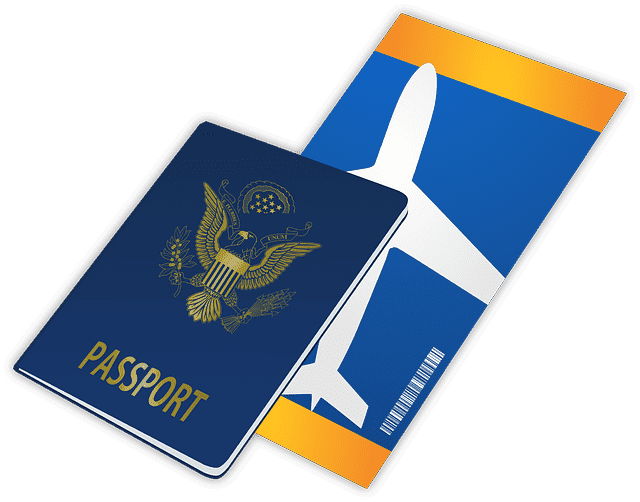Who Needs ETIAS and How It Works
If you’re from a country that doesn’t require a visa to enter the European Union or Schengen Area, you must have an ETIAS travel authorization before your trip. This includes travelers visiting for tourism, business, medical, or transit purposes, and it applies to stays of up to 90 days within a 180-day period.
ETIAS connects to your passport electronically, meaning there’s no need for physical stamps or stickers. Once approved, your authorization remains valid for three years or until your passport expires — whichever comes first.
When it’s time to travel, border officers and airline staff can verify your ETIAS directly in the system. It’s a small step before your trip that helps maintain both your safety and Europe’s border integrity.
How to Apply for ETIAS
Applying for ETIAS is a quick and simple online process. You can complete the entire application through the ETIAS website. During the application, you’ll be asked to provide personal details, passport information, travel plans, and security-related questions.
After submission, the system automatically checks your information against various security databases. Most applications are processed within a few minutes, but in some cases, additional checks may take longer.
To avoid travel disruptions, it’s best to apply well in advance of your departure date. Once your application is approved, you’ll receive confirmation by email — no physical documents required.

What Happens After Submission
Once your application is sent, it undergoes automatic screening. If no issues are detected, your authorization is usually granted within minutes. However, if additional details are required, you may receive a request to provide extra documentation or attend an interview.
In most cases, these requests are rare, but if they occur, be sure to respond within the given timeframe. Failing to do so may result in a refusal. Once approved, your ETIAS becomes digitally linked to your travel document, allowing smooth travel between participating European countries.
Correcting or Updating Your Application
Accuracy is crucial when applying for ETIAS. Errors in your application can lead to refusal, revocation, or even problems at the border. Before submitting, review every detail carefully — especially your passport number, nationality, and email address.
If you notice a mistake after submission, the fastest solution is to apply for a new ETIAS authorization using the correct information. This method is more convenient than requesting manual corrections, which may take up to 30 days to process.
You’ll also need a new ETIAS if you:
• Change your name, gender, or nationality
• Replace or renew your passport
• Lose your travel document while in Europe
In case of a lost or stolen passport, report it to local authorities immediately and request a replacement from your country’s consulate. Once you receive a new travel document, apply again for a new ETIAS authorization linked to it.
If you lose access to the email you used in your application, your ETIAS remains valid, but you’ll stop receiving updates and notifications. For convenience, it’s recommended to reapply using a new, accessible email address.

Special Cases and Exemptions
Certain travelers may be exempt from the ETIAS requirement, while others may face specific conditions depending on their situation. Here’s what you need to know:
1. Urgent Travel Situations
Even for urgent trips, such as emergencies or last-minute plans, you must still hold a valid ETIAS. Fortunately, most applications are processed almost instantly, allowing you to apply shortly before your journey if needed.
2. Refusal and Urgent Needs
If your ETIAS application is refused but you must travel for humanitarian, medical, or legal reasons — such as attending a funeral, a court appearance, or medical treatment — you may request a limited-validity ETIAS authorization.
3. Refugees and Stateless Persons
Refugees or stateless individuals who live in a European country that requires ETIAS and have travel documents issued by that country do not need ETIAS. However, if you’re a recognized refugee or stateless person residing in a visa-exempt country outside the EU, you may still need ETIAS depending on where you plan to go.
Always check your travel requirements carefully, as rules vary across countries. Some European destinations may require ETIAS, while others still require a visa.
4. Diplomats
In general, holders of diplomatic passports don’t need ETIAS. However, certain exceptions exist depending on the issuing country and the type of diplomatic document held. Always verify the entry requirements before traveling.
5. Permanent Residents in the EU
If you come from a visa-exempt country but already live permanently in the EU, you don’t need ETIAS. Having a residence card, residence permit, or any document that authorizes your stay in a European country means you’re already exempt.
6. Students and School Trips
Students who normally need a visa but study in a visa-exempt country may qualify for ETIAS if they join a school trip and meet specific conditions. Your eligibility depends on both your nationality and your country of residence, so always confirm travel requirements beforehand.
7. Air and Sea Crew Members
Crew members working on airplanes or ships may or may not need ETIAS, depending on the type of duty and destination country. Each European country applies its own rules for crew on duty, seafarers, or emergency teams. Always verify entry rules before departure.
8. Family Members of EU Nationals
If you’re a family member of an EU citizen or of a national of Iceland, Liechtenstein, Norway, or Switzerland, you may be exempt from paying the ETIAS fee. Family members typically include spouses (including same-sex partners), registered partners, children under 21, dependents, and dependent parents or grandparents.
However, you must meet certain legal conditions to qualify for this exemption. If you’re traveling to a country where your family member resides but you’re not covered by EU free movement rules, you’ll need to apply for ETIAS like any other traveler.
9. NATO Personnel
Members of NATO armed forces traveling on official duty don’t need ETIAS, as long as they hold the proper identification and movement orders. However, if you plan to travel for private purposes while in Europe, an ETIAS authorization or visa is required.
10. Dual Nationality and British Travelers
If you hold citizenship from both a visa-exempt country and a European country requiring ETIAS, use your European passport for travel — no authorization is needed. British nationals, including overseas citizens and protected persons, must apply for ETIAS unless they fall under special withdrawal agreement conditions.
Transit and Border Area Travel
If you’re only transiting through a European airport without leaving the international transit zone, you don’t need ETIAS. However, once you exit the transit area and enter the country’s territory, a valid ETIAS becomes mandatory.
Similarly, if you hold a local border traffic permit, you can move freely within the designated border zone without ETIAS. But if you plan to travel beyond that area, you’ll need to apply for authorization.

Application Fees and Payment Process
When applying for your ETIAS travel authorisation through the platform, a small application fee is required. The charge is EUR 38.23, which helps cover processing and system maintenance costs. However, certain applicants are exempt from payment, including those under 18 years old, over 70 years old, and family members of EU citizens or non-EU nationals with free movement rights within the European Union.
Keep in mind that this fee is non-refundable, regardless of the outcome of your application. Even if your ETIAS authorisation is denied, revoked, or annulled, the fee cannot be reimbursed. This rule ensures the system’s sustainability and efficiency while maintaining a uniform approach for all applicants.
Before submitting payment, it’s essential to review your details carefully. Errors in your application could result in processing delays or refusal, but the payment will remain non-refundable. The ETIAS system uses secure online payment channels, making it easy and safe to complete your transaction directly on the site.
Traveling with ETIAS: What to Know Before Your Trip
Once your ETIAS authorisation is approved, traveling to the participating European countries becomes smoother—but it’s important to understand the scope of what your authorisation provides.
There is no requirement to print your ETIAS document since airline staff, ferry operators, and border guards can access it electronically through the system. However, carrying a printed copy may still be helpful for your own peace of mind, especially if you want to keep personal records or travel documents organised.
It’s also crucial to remember that ETIAS approval does not guarantee entry into any European country. Border guards at the point of entry make the final decision based on local laws, immigration policies, and security conditions. Even with a valid ETIAS, you may be asked to provide additional documents, such as proof of accommodation, return tickets, or travel insurance.
In rare cases, entry can be refused if authorities identify security concerns, incomplete travel justification, or inconsistencies in your information. ETIAS simply allows you to board your transport and arrive at the border, where the final check takes place.
ETIAS Validity and Renewal Guidelines
ETIAS is designed for long-term convenience, allowing travelers to make multiple visits without reapplying frequently. However, its validity period depends largely on the expiration date of your passport.
An ETIAS authorisation remains valid for three years or until your passport expires, whichever comes first. This means that if your passport has only two years of validity remaining, your ETIAS will also expire after those two years.
When your ETIAS is close to expiring, you’ll receive an automatic email reminder notifying you of the upcoming deadline. Travelers are allowed to apply for a renewal up to 120 days before the expiration date. Renewing your ETIAS early ensures that you won’t face travel disruptions or unexpected delays during future trips.
If your children received their ETIAS while they were minors, the authorisation will remain valid until its expiry date, even if they have since turned 18. The system bases validity strictly on the document’s expiration, not on age changes after approval.
It’s a good practice to check both your passport and ETIAS validity before planning your travel to avoid surprises at the border. Expired authorisations cannot be renewed automatically—you must submit a new application using updated travel details and identification.
Ensuring Data Security and Privacy Protection
ETIAS places a strong emphasis on data protection and cybersecurity. All personal details you submit—such as your name, travel information, and background details—are stored within a centralised, secure database managed by multiple European agencies.
The entities responsible for maintaining and safeguarding ETIAS data include:
• eu-LISA (European Union Agency for the Operational Management of Large-Scale IT Systems)
• Frontex (European Border and Coast Guard Agency)
• Europol (European Union Agency for Law Enforcement Cooperation)
• National authorities of the participating European countries
These organisations use advanced encryption, layered security systems, and strict access protocols to prevent unauthorised data access or misuse. Only authorised personnel can view or handle personal information, and even then, their access is limited to what is necessary for their duties.
Payment security is also treated with the highest level of protection. During the online transaction process, payment details are handled exclusively by financial intermediaries or banks responsible for processing the payment. The ETIAS central system does not store or retain payment data once the transaction is complete. This approach ensures your bank and card information remain confidential and isolated from the rest of the system.
By design, ETIAS aligns with the European Union’s General Data Protection Regulation (GDPR), guaranteeing that every applicant’s data is handled lawfully, transparently, and for the intended purpose of border and travel management only.
Your Right to Appeal ETIAS Decisions
If your ETIAS application is refused, or your authorisation is revoked or annulled, you will be promptly informed by email. The message will include the specific reasons behind the decision, along with details about the national authority responsible for making it.
As an applicant, you maintain the right to appeal. The email will guide you through the process, specifying which European country’s legal framework applies to your appeal and how to submit it properly. Each appeal is handled according to that country’s national laws and regulations.
It’s important to note that if your ETIAS is revoked at your own request, you cannot appeal the decision, as it was initiated voluntarily.
Understanding this appeals process ensures transparency and gives applicants confidence that they can seek reconsideration if they believe their application was unfairly denied or cancelled.
Final Thoughts: A Simpler Way to Travel in Europe
ETIAS has been designed to simplify travel for millions of non-EU citizens while maintaining a high level of security and border protection. The system ensures that travelers undergo a quick, online pre-screening process, reducing waiting times at borders and improving overall safety across participating European countries.
With ETIAS, you can experience smoother entry procedures and peace of mind, knowing your authorisation is securely managed, valid for multiple visits, and easily renewable. By understanding the process—application, payment, validity, renewal, and data protection—you can travel confidently across Europe with all the necessary documentation in place.